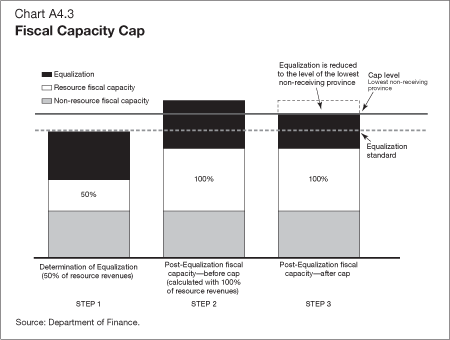Common menu bar links
Restoring Fiscal Balance for a Stronger Federation
Introduction
Budget 2007 proposes to restore fiscal balance in Canada. This annex provides an overview of major federal transfers, including additional technical details on the changes proposed to Canada's major transfers to provinces and territories, including Equalization, Territorial Formula Financing, the Canada Social Transfer and the Canada Health Transfer, as well as targeted support for wait times reduction. The following chart provides an indication of the relative size of each of these transfers.
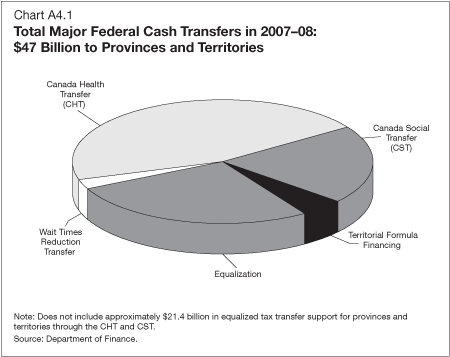
Additional details on funding for labour market training can be found in Chapter 5 in the "Knowledge Advantage" section. Additional details on the proposed changes to infrastructure funds can be found in the "Infrastructure Advantage" section of Chapter 5.
Equalization
Equalization is a constitutionally mandated program by which the federal government makes payments to less prosperous provinces to help them provide their residents with public services that are reasonably comparable to those in other provinces, at reasonably comparable levels of taxation. This program plays an important role in supporting the equal treatment of Canadians wherever they live.
The Equalization program has existed since 1957, and the principle of equalization has been enshrined in the Constitution of Canada since 1982:
Parliament and the government of Canada are committed to the principle of making equalization payments to ensure that provincial governments have sufficient revenues to provide reasonably comparable levels of public services at reasonably comparable levels of taxation. [Section 36(2)]
Equalization is a strictly federal program. Provinces do not make direct contributions to each other. It is not a wealth transfer from province to province. Equalization is funded from general tax revenue collected by the federal government from all Canadian citizens and businesses, no matter where in Canada they reside.
A Renewed and Strengthened Equalization Program
Budget 2007 puts in place a renewed and strengthened Equalization program, legislated through 2013-14 to provide long-term predictability for provinces. The new program is based on the recommendations put forward in June 2006 by the Expert Panel on Equalization and Territorial Formula Financing (chaired by Al O'Brien). It includes provisions that meet the commitments to exclude revenues from non-renewable natural resources and to respect the Offshore Accords.
The new program will ensure that Equalization payments are put back on the basis of a formula-driven measure of provincial fiscal disparities. Provinces with relatively low fiscal capacities will receive the most on a per capita basis, while provinces with higher fiscal capacities will receive less. As a province's relative fiscal capacity grows (or declines), the new program will ensure that payments decline (or grow) accordingly. As relative fiscal capacities change, some provinces may no longer qualify for Equalization payments, while others may begin to qualify. This is the proper functioning of a formula-driven, principles-based program.
The new program will be fair to Canadians in all provinces by ensuring, through the introduction of a fiscal capacity cap, that Equalization payments do not raise any receiving province's total fiscal capacity above that of any non-receiving province.
The main elements of the renewed program include:
- A higher Equalization standard.
- A new approach to the treatment of natural resources.
- A fiscal capacity cap.
- A simplified measurement of fiscal capacity.
- Stable and predictable payments.
- Fulfilling the commitment to exclude non-renewable resource revenues.
- Fulfilling the commitment to respect the Offshore Accords.
A Higher Equalization Standard
The Equalization standard is the level to which Equalization payments raise the fiscal capacity of receiving provinces. The standard determines the total size of the Equalization program, since provinces with a fiscal capacity below the standard receive payments to bring them up to that level. Provinces with a fiscal capacity above the standard do not receive payments. In this way, the standard represents the "dividing line" between receiving provinces and non-receiving provinces at any given time.
The standard has changed many times since 1957 but, except in the past few years, has always been representative of the fiscal capacity of some or all of the provinces. In the early years of the program, a "top-two provinces" standard was used, giving way to a 10-province (or "national average") standard in the 1960s. From 1982 to 2004, the standard was based on the average of the fiscal capacities of five provinces (British Columbia, Saskatchewan, Manitoba, Ontario and Quebec).
The 5-province standard, which excluded Alberta and its natural resources, was introduced to reduce volatility from resource revenues and control the program's overall cost at a time of high federal budget deficits. To balance the exclusion of Alberta, the Atlantic provinces were also excluded from the standard. Although this standard was appealing from a cost-control and stability perspective, it fell short of being a truly national standard.
The 2004 fixed funding envelope approach, on the other hand, moved away from the concept of a representative standard altogether and replaced it with a floating standard, which was not necessarily reflective of the fiscal capacity of any province or group of provinces.
The Equalization standard in the new program will reflect the recommendation in Achieving A National Purpose: Putting Equalization Back on Track (the O'Brien report) and will be based on the fiscal capacity of all 10 provinces. The overall program cost will be determined by the application of the formula. Annual volatility associated with a 10-province standard will be addressed through the use of a weighted three-year moving average calculation for payments.
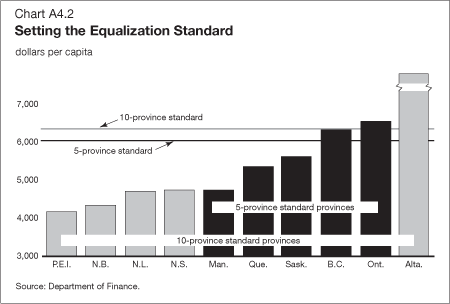
A New Approach to the Treatment of Natural Resources
The treatment of natural resources has long been one of the most contentious issues in the Equalization program. This is due in part to the uneven distribution of natural resource wealth across provinces. Debate about natural resources has focused on two key issues-the appropriate inclusion rate and how to measure fiscal capacity.
Inclusion Rate
Some commentators support the full exclusion of natural resource revenues, arguing that including them unfairly limits the benefits that provinces receive from their natural resources, and creates disincentives to the development of those resources. It is argued that full exclusion would provide provinces with the right incentives to fully develop their resources and tax them appropriately, recognize the extraordinary public costs involved in resource management and administration, and address the issue of volatility associated with full resource inclusion.
Other commentators support full resource inclusion, arguing that these revenues are a source of significant provincial fiscal disparities, and that excluding them would unfairly underestimate the fiscal capacity of resource rich provinces and transfer more Equalization to those provinces at the expense of other provinces.
The new program adopts the O'Brien report's recommendation to exclude 50 per cent of provincial natural resource revenues, and provides provinces with the benefit of full exclusion without reducing payments to any province.
Measurement of Fiscal Capacity
Determining the correct measure of fiscal capacity for natural resource revenues has always been problematic. Provincial resource royalty regimes are quite specific to each province and industry, given the varying amount of economic rent different natural resources will generate. This makes it a challenge to use the Representative Tax System approach that is used for other tax bases, which simulates how much revenue a province could raise if it levied the national average tax rate using a typical tax system. Often, when average tax rates are applied to these bases, without taking into account differences in the economic rent generated by a given dollar or volume of production, the result is a measure of capacity that is very different from what the provinces can actually collect.
Based on its recommended 50-per-cent inclusion rate, the O'Brien report proposed the use of actual revenues to measure fiscal capacity from natural resources, thus addressing many of the measurement difficulties.
Under the previous system, which generally included 100 per cent of resource revenues, using actual revenues could have presented provinces with an incentive to reduce their royalty rates given that this would have resulted in a full offset provided by higher Equalization payments. Such incentives would be detrimental to the appropriate management and taxation of natural resources. These disincentive issues are addressed by the 50-per-cent inclusion rate recommended in the O'Brien report.
The use of actual revenues also permits an important program simplification, as the 14 separate bases used previously can be consolidated into a single natural resource revenue base.
Fiscal Capacity Cap
The partial exclusion of natural resource revenues from the Equalization formula benefits provinces with such revenues. It also makes it possible for a receiving province with natural resources to end up with a post-Equalization fiscal capacity that exceeds that of a non-receiving province. This is because the exclusion of resource revenues lowers a province's measured fiscal capacity and leads to higher Equalization payments. When the excluded resources are included in the measure of total fiscal capacity, it is possible that Equalization payments may have raised a province's total fiscal capacity above that of a non-receiving province. This would create a situation that would be unfair to the residents of non-receiving provinces, whose taxes are also used to fund payments to provinces better off than their own.
The new program will therefore include a fiscal capacity cap, as recommended by the O'Brien report, to ensure that Equalization payments do not raise a province's total fiscal capacity above that of any non-receiving province. The definition of total fiscal capacity for the purpose of the cap will include fiscal capacity for non-resource revenue sources, 100 per cent of natural resource revenues and Equalization offset payments made pursuant to the Offshore Accords with Newfoundland and Labrador and Nova Scotia.
The following chart demonstrates how the fiscal capacity cap ensures that Equalization payments do not push a receiving province's total fiscal capacity above that of any non-receiving province. Steps 1 and 2 show that Equalization based on 50-per-cent resource inclusion can result in a receiving province having a higher post-Equalization total fiscal capacity than a non-receiving province. In Step 3, the application of the fiscal capacity cap limits Equalization to ensure that the total fiscal capacity of the province is not higher than that of the lowest non-receiving province.
A Simplified Measurement of Fiscal Capacity
At its inception, the Equalization program had only 3 tax bases. Over time, the number of bases has grown to 33. While this increase has accompanied the expansion of Equalization's coverage of provincial revenue sources, this increase in the number of bases has also added complexity and reduced transparency, making the program more difficult to understand and less open to scrutiny. A large number of bases can also create incentives or disincentives for provincial governments that can affect their decisions on taxation and public investments.
For these reasons, the measurement of provincial fiscal capacity will be simplified based on the recommendation of the O'Brien report. Instead of 33 tax bases, provincial fiscal capacity will be measured using 5 tax bases-personal income tax, business income tax, consumption tax, property tax and natural resource revenues.
- Personal income tax fiscal capacity will be measured using the average amount of tax that could be raised in each of the 10 provinces under each of the 10 provincial personal income tax systems. Total equalized revenues in this base will also include payroll tax revenues.
- Business income tax fiscal capacity will be measured using corporation and government business enterprise profits. Total equalized revenues in this base will also include capital tax revenues.
- Consumption tax fiscal capacity will be measured on the basis of the sales in a province that would generally be subject to provincial sales tax in most provinces. Total equalized revenues in this base will also include revenues derived from: tobacco taxes, gasoline taxes, diesel fuel taxes, non-commercial vehicle licences, commercial vehicle licences, alcohol sales, hospital and medical insurance premium taxes, race track sales, insurance premiums, lottery ticket sales, other games of chance, and preferred share dividends.
- Property tax fiscal capacity will be measured using three components: the residential sector, the commercial-industrial sector and the farm sector. The new base will use adjusted provincial market values as the measure of fiscal capacity for residential property taxes. Total equalized revenues in this base will also include the various miscellaneous revenues collected by provincial and municipal governments. Revenues from user fees will be excluded.
- As noted above, fiscal capacity from natural resources will be measured using actual revenues.
Stable and Predictable Payments
Persistent concerns were raised regarding the estimation and payment structure under the previous system. Equalization payments for a given year were estimated seven times over a four-year period as new data became available, until a final calculation could be made. The estimation process lasted 42 months between the first estimate and the final calculation. This situation resulted in payments being unpredictable, as unanticipated economic developments in certain provinces and data revisions would regularly make it difficult for provinces to forecast what payments they would receive.
Provinces also expressed concerns about the stability of payments. Although it is important that the Equalization program remain responsive to changes in provincial economic conditions, the impact of large fluctuations in a province's year-over-year payments needed to be addressed. These concerns led to the introduction of a three-year moving average during the 2004 renewal.
The new Equalization program will have a single-estimate system, as recommended by the O'Brien report, to ensure that Equalization payments will be both predictable and stable. Equalization payments will be determined in advance of each fiscal year and will not be subject to revision, ensuring that provinces have certainty for budget planning. In addition, the O'Brien report's recommendation that payments should be based on a three-year weighted moving average of provincial fiscal capacity, lagged two years, will be implemented, ensuring more stable payments over time.
The following chart demonstrates how the three-year weighted moving average with a two-year data lag will be used to calculate payments for a given fiscal year.
Table A4.1Annual Fiscal Capacity Calculation (With Weights)
| 2003-04 | 2004-05 | 2005-06 | 2006-07 | 2007-08 | Payment Year |
|---|---|---|---|---|---|
| 25% | 25% | 50% | 2007-08 | ||
| 25% | 25% | 50% | 2008-09 | ||
| 25% | 25% | 50% | 2009-10 | ||
| Source: Department of Finance. | |||||
Fulfilling the Commitment to Exclude Non-Renewable Resource Revenues
The new Equalization formula-which includes a 10-province standard with 50 per cent of natural resource revenues-provides a higher standard than either the previous system or one that fully excludes non-renewable natural resources. As a result, the new program provides higher overall payments and an incentive to encourage resource development.
Consistent with the Government's commitment, the new program will allow provinces to receive the greater of their Equalization payments under the new formula using 50 per cent resource exclusion and the amounts they would receive under the same formula with full exclusion of natural resource revenues. This will further improve incentives and provide additional protection against future declines in resource prices and production levels.
Excluding 100 per cent of natural resource revenues has two effects-operating in opposite directions-on a province's Equalization calculations.
- First, excluding all resource revenues lowers the Equalization standard, potentially decreasing Equalization payments to all provinces.
- Second, the exclusion of resource revenues lowers the measured fiscal capacity of each individual province, potentially increasing Equalization payments to each province, since the gap that Equalization fills between the standard and each province's fiscal capacity increases.
For provinces with relatively low resource revenues, the drop in the standard outweighs the benefits of their lowered measured fiscal capacity, so their Equalization payments would decline.
For provinces with relatively high resource revenues, the benefit from their lowered measured fiscal capacity exceeds the negative impact of the drop in the standard, resulting in higher potential Equalization payments to these provinces.
The following chart provides a stylized example. For the province with relatively low resource revenues, the gap-and therefore the potential Equalization-between the standard and its fiscal capacity is greater with 50 per cent exclusion than with full exclusion. The opposite is true for the province with relatively high resource revenues.
It is important to note that the fiscal capacity cap plays an integral role in the calculation of payments under both exclusion rate scenarios. Resource-rich provinces that are already at the fiscal capacity cap under the calculation with 50 per cent exclusion could not receive additional payments with full exclusion. Otherwise, Equalization would push that province's fiscal capacity above that of a non-Equalization-receiving province, undercutting a fundamental principle of fairness that is being established with the new system.
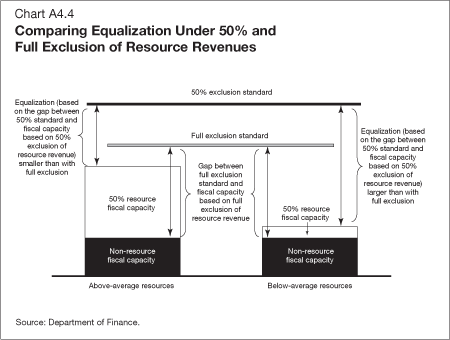
As shown in the table below, under current resource prices and production levels, the O'Brien formula with 50 per cent resource exclusion provides higher overall benefits and greater or equal individual benefits to all receiving provinces than would full resource exclusion.
Table A4.2Equalization: 50 per cent vs. Full Exclusion in 2007-08 (millions of dollars)
| N.L. | P.E.I. | N.S. | N.B. | Que. | Ont. | Man. | Sask. | Alta. | B.C. | Total | |
|---|---|---|---|---|---|---|---|---|---|---|---|
| 50% exclusion of resources | 4771 | 294 | 1,3081 | 1,477 | 7,160 | - | 1,826 | 226 | - | - | 12,768 |
| 100% exclusion of resources | 4771 | 247 | 1,3081 | 1,257 | 5,202 | - | 1,508 | 226 | - | - | 10,224 |
| - | 47 | - | 220 | 1,959 | - | 318 | - | - | - | 2,543 | |
| Note: Totals may not add due to rounding. 1 Calculations for Newfoundland and Labrador and Nova Scotia are assumed to continue to operate under the previous system. Source: Department of Finance. |
|||||||||||
Table A4.2 Shows that:
- Provinces with relatively low resource revenues-Prince Edward Island, New Brunswick, Quebec and Manitoba-receive higher payments under the new formula with 50 per cent inclusion than with full exclusion, since the higher standard under 50 per cent exclusion outweighs the benefits of having all resources excluded in the measurement of fiscal capacity.
- Saskatchewan, which has above average resource revenues, receives identical payments under both calculations. This is because under both calculations, its Equalization is limited to $226 million-any additional payments would push the province above Ontario's fiscal capacity, undercutting a fundamental principle of fairness.
While payments to individual provinces in 2007-08 under 50 per cent resource exclusion are greater than or equal to the payments they would receive under full resource exclusion, this could change in future years depending upon resource prices and production levels.
Fulfilling the Commitment to Respect the Offshore Accords
At the time the 2005 Offshore Accords were signed, total Equalization payments were based on the fixed envelope approach and were allocated on the basis of a formula that took into account fiscal capacities reflecting the provisions of the 2004 renewal. To respect the Offshore Accords, Budget 2007 puts in place transitional provisions under which Newfoundland and Labrador and Nova Scotia will continue to receive payments under that Equalization program. Both provinces will be able to permanently opt into the new Equalization program at any time.
Newfoundland and Labrador and Nova Scotia each have an Accord with the federal government, signed in 2005, that provides them with time-limited payments to fully offset any reductions in Equalization that would otherwise be triggered by their offshore revenues.
These Accords were made in recognition of the unique fiscal situations of these two provinces, notably the very high debt burdens that make it difficult to provide their residents with provincial public services that are comparable to those in other provinces at comparable levels of taxation.
The 2005 Offshore Accords provide for:
- 100-per-cent protection from Equalization reductions, or "clawbacks," through 2011-12, for each province as long as it continues to receive Equalization payments.
- Up-front payments of $2 billion for Newfoundland and Labrador and $830 million for Nova Scotia (made in 2005), to provide each of them with immediate flexibility to address their unique fiscal challenges.
- Continued application of the offset provisions of the pre-existing Atlantic Accord for Newfoundland and Labrador, also applicable for Nova Scotia should it no longer otherwise qualify for Equalization payments.
- Provision for a further eight-year extension of the 2005 Accords, through 2019-20, for each province as long as it receives Equalization in 2010-11 or 2011-12 and meets specific criteria related to its debt.
- Transitional payments during the extended eight-year period for each province should it no longer otherwise qualify for Equalization payments.
With the protection of their Offshore Accords, Newfoundland and Labrador and Nova Scotia will continue to have the opportunity to make sustained improvements to their economic and fiscal situations.
Territorial Formula Financing
Territorial Formula Financing (TFF) is an annual, unconditional transfer from the federal government to territorial governments. Similar to Equalization, it enables Canada's three territorial governments to provide a range of public services comparable to those offered by provincial governments at comparable levels of taxation, taking into account the higher costs of services and unique circumstances in the north.
Although territorial governments raise revenues by taxation, rentals and sales of goods and services, the TFF grant forms a significant portion of total territorial financial resources: in 2006-07, the TFF grant made up 59 per cent, 63 per cent and 81 per cent of total territorial revenues for Yukon, the Northwest Territories and Nunavut respectively. Funding for TFF is funded from general tax revenue collected by the federal government from all Canadian citizens and businesses, no matter where in Canada they reside.
A Renewed and Strengthened Territorial Formula Financing
Budget 2007 puts in place a long-term legislated TFF arrangement that follows the recommendations in Achieving a National Purpose: Improving Territorial Formula Financing and Strengthening Canada's Territories (the O'Brien report), which were supported by all three territories.
The main elements of the renewed program include:
- A separate gap-filling formula for each territory.
- A simplified measurement of territorial revenues.
- Improved incentives for territories to develop their economies and increase their own-source revenues.
- A simplified estimate and payment system to increase predictability.
A Separate Gap-Filling Formula for Each Territory
The new program will return TFF to a gap-filling formula that includes a measure of each territory's total needs and a measure of each territory's revenue-raising capacity. This will make TFF flexible enough to recognize the very real diversity among the territories, address concerns with the adequacy of TFF and simplify the TFF formula, while providing incentives for the territories to raise their own revenues. The annual grant for each territory will again be calculated as the difference between a territory's assessed need and its capacity to generate revenues.
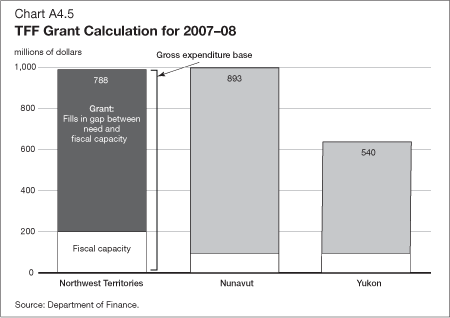
To build on the additional funding that was provided to territories in recent years, a new gross expenditure base (GEB) for each territory will start from this higher level. These new GEBs will be used as the approximate measure of territorial expenditure need.
Consistent with the O'Brien report's recommendation, annual growth of the new GEBs will be based on changes in provincial-local spending and the relative growth in territorial population to that of the country as a whole, through an escalator, called the population-adjusted gross expenditure escalator (PAGE). This will ensure that territorial revenues grow in line with provincial spending and relative population growth. A three-year moving average, lagged two years, will be used to calculate the PAGE escalator for each territory.
A Simplified Measurement of Territorial Revenues
Consistent with the approach used in the Equalization program, a Representative Tax System (RTS) approach will be used to measure territorial revenue capacity. This will simplify the TFF program while ensuring that revenue coverage is consistent with coverage under Equalization.
Territorial revenue capacity will be measured using the RTS for the following revenue bases: personal income, business income, tobacco, gasoline, diesel fuel, alcoholic beverages and payroll.
The remaining 11 non-resource revenue bases (capital tax, general and miscellaneous sales taxes, commercial and non-commercial vehicle licences, hospital and medical insurance premiums, insurance premiums, property tax, lottery and other games of chance revenues, miscellaneous revenues and preferred share dividends) will be grouped into a revenue block using actual revenues and a common escalator of 2 per cent for future years.
Improved Incentives for Territories to Develop Their Economies and Increase Their Own-Source Revenues
The Government will improve incentives for the territories to raise their own revenues and help promote economic development by excluding 30 per cent of territories' measured revenue capacity in the formula. This means that 30 cents of every new dollar the territories raise through their own revenue sources will not be considered in the determination of the TFF.
A Simplified Estimate and Payment System to Increase Predictability
Prior to 2004, territorial grant payments were made using an eight-estimate system (seven estimates plus a final calculation). Under the new TFF, a single-estimate system using a three-year moving average with a two-year lag will be put in place. This will greatly simplify the program. It will also enhance transparency and accountability by eliminating the adjustments under the previous program that were made to each of four fiscal years at any one time. Using a single-estimate system will also ensure a consistent payment approach between Equalization and TFF.
Table A4.3Annual Fiscal Capacity Calculation
| 2003-04 | 2004-05 | 2005-06 | 2006-07 | 2007-08 | Payment Year |
|---|---|---|---|---|---|
| 33% | 33% | 33% | 2007-08 | ||
| 33% | 33% | 33% | 2008-09 | ||
| 33% | 33% | 33% | 2009-10 | ||
| Source: Department of Finance. | |||||
Beyond TFF-Restoring Fiscal Balance in the North
The situation in Canada's three territories is vastly different from the challenges faced by provinces: the majority of communities are small and isolated; population growth tends to outpace that of the rest of Canada; and costs, including the cost of providing public services, are very high. There are also serious disparities in outcomes for health, education and social well-being compared with the rest of Canada. Nowhere is this more evident than in Canada's newest territory, Nunavut.
Budget 2006 provided immediate funding to improve the economic and social conditions faced by northerners:
- A one-time payment of $300 million to address the serious affordable housing pressures faced by the territories. The funding was allocated over three years and distributed between the territories as follows: $50 million each, plus an additional $150 million to address the particularly urgent housing situation in Nunavut.
- A $500-million fund over 10 years for communities in the Northwest Territories to mitigate negative socio-economic effects arising from the Mackenzie Gas Project.
- $2.96 million, $4.14 million and $2.89 million respectively to Yukon, the Northwest Territories and Nunavut for additional support for public transit, post-secondary education infrastructure and affordable housing.
The TFF program proposed in Budget 2007 will go a long way toward achieving this objective by providing territories with an additional $115 million in 2007-08, compared to 2006-07.
In addition to the benefits flowing to the territories from other infrastructure investments announced in Budget 2007, each territory will also be provided with annual funding of $25 million in recognition of the urgent infrastructure needs that exist in Canada's north. This funding will help territories build and upgrade their infrastructure, including that required to facilitate economic and resource development.
Canada's three territories will also benefit from the Government's $1.5-billion ecoTrust for Clean Air and Climate Change to develop technology, energy efficiency and other projects that will provide real results to the people of the north by providing $5 million to each of the three territories.
Territories will also benefit from other fiscal balance measures in Budget 2007, including growing Canada Social Transfer funding and the new approach to labour market training.
As recommended by the 2005 Report of the Auditor General of Canada to the Legislative Assembly of Nunavut, and to address what the Government of Nunavut has indicated is a key priority, Budget 2007 will provide the Government of Nunavut with an additional $23 million in funding to support its efforts to strengthen its financial management practices and systems.
The transfer of legislative powers and administrative responsibilities from the federal government to territorial public governments to provide for greater local control and accountability has been a federal policy objective since the 1970s. Consistent with this policy, the devolution of the administration and control over onshore natural resources was completed in Yukon in 2003.
Discussions will continue towards a similar devolution of the responsibility for the administration of lands and onshore natural resources to the Government of the Northwest Territories. As part of devolution, Canada is committed to ensuring that the Government of the Northwest Territories has the resources to undertake its new responsibilities. Resource revenue-sharing arrangements determine how resource revenues received after devolution will offset future annual unconditional grants from the Government of Canada through the TFF program.
Main devolution negotiations with the Northwest Territories commenced in October 2002. A Devolution Framework Agreement was signed in March 2004 and negotiations were then undertaken towards an Agreement-In-Principle.
The TFF program is now on a renewed, principles-based footing.
Resource revenue-sharing discussions will now continue within the context of overall devolution negotiations. As recommended by the O'Brien report, the Government will continue to treat natural resource revenues outside of TFF. Consistent with Equalization, 50 per cent of resource revenues will be excluded from the offset calculation against the TFF grant up to an overall cap, providing a net fiscal benefit and an additional incentive to develop natural resources.
In addition, to support new resource development in the Northwest Territories and in recognition of the territory's strong economic outlook and independent credit rating, Canada's New Government will raise the Government of Northwest Territories' borrowing limit from $300 million to $500 million.
Health and Social Transfers
The federal government uses transfers to support provincial and territorial governments in providing health care, post-secondary education, social assistance and social services, and support for children.
Over the past decade, federal support for health and social programs has undergone a number of changes. In the mid-1990s federal health and social transfer support was consolidated under the former Canada Health and Social Transfer (CHST), and cash transfers were reduced as a part of the government-wide deficit reduction measures. As the federal fiscal situation improved, investments in transfers were undertaken; by 2002-03, overall cash transfer levels had been restored to pre-CHST levels.
Effective April 1, 2004, the CHST was restructured into two separate block transfers: the Canada Health Transfer, a dedicated transfer for health, and the Canada Social Transfer, a transfer in support of post-secondary education, social assistance and social services, and early childhood development and learning and child care. Provinces and territories continued to have flexibility in allocating funding to the supported areas within each transfer, but with greater emphasis on public reporting to enhance accountability.
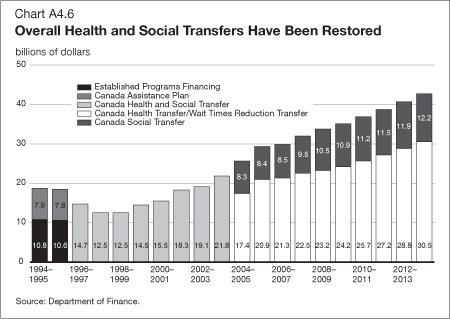
Strengthened Federal Support for Health Care
As one of its first measures to restore fiscal balance, Canada's New Government reaffirmed its commitment to the principles of the Canada Health Act and followed through on the implementation of the 10-Year Plan to Strengthen Health Care. The 10-Year Plan increased funding for the CHT, legislated it out to 2013-14, and applied an automatic annual escalator of 6 per cent to ensure growing support. Over the 10-year timeframe of the Plan, legislated federal cash transfers for health, including increased funding for medical equipment and long-term funding for wait times reduction, were increased by $41.3 billion. By 2013-14, CHT cash transfers and wait times funding will reach $30.5 billion.
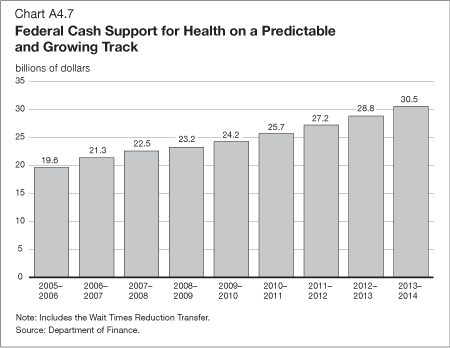
A Renewed and Strengthened Canada Social Transfer
Over the past few years, concerns have been raised regarding the predictability and stability, as well as transparency and accountability, of federal support for post-secondary education and social programs provided through the CST.
Recent increases to the CST have been primarily targeted to support early childhood development and child care, a prominent new area of support within the CST. Federal transfer support for post-secondary education and social programs has not experienced the same level of transfer increases as support for health care, although there have been considerable investments in federal direct support in these areas.
This direct federal support, including the new Working Income Tax Benefit, is an important complement to the investments being made in the CST, ensuring governments are able to meet the needs of Canadians.
Budget 2007 proposes to put the CST on a long-term, predictable path and make it more transparent and fair. The main elements of the renewed and strengthened CST include:
- Long-term, predictable and enhanced funding.
- Greater transparency for Canadians.
- Investing $687 million for fair, equal per capita cash support.
- A smooth transition to the new system.
Long-Term, Predictable and Enhanced Funding
Budget 2007 will enhance the stability and predictability of support to provinces and territories for post-secondary education and social programs by extending the legislated funding framework of the CST to 2013-14. As a result, the CST will be put on the same long-term legislated track as the CHT.
In addition, Budget 2007 will legislate an automatic 3-per-cent escalator, effective in 2009-10. This escalator will provide for funding that is predictable and growing in line with inflation and population. By 2013-14, the escalator will have provided over $4.9 billion in additional support to provinces and territories.
Furthermore, Budget 2007 is making new investments in the CST. In addition to the legislated base increase of $300 million in 2007-08, an additional $687 million will be added to the CST to facilitate the move to equal per capita cash support, raising the overall CST cash level to $9.5 billion. In 2008-09, an additional $800 million for post-secondary education and $250 million for the creation of new child care spaces will be invested in the CST, bringing the overall CST cash level to $10.5 billion. Starting in 2009-10, this overall level will be increased by 3 per cent annually to reach $12.2 billion by 2013-14.
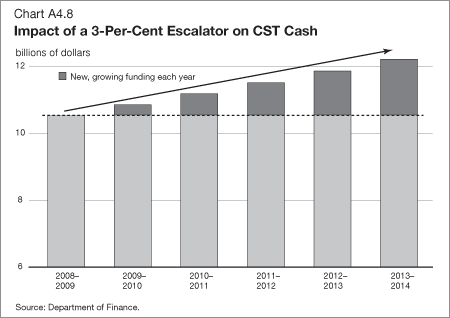
Greater Transparency for Canadians
To address concerns regarding the transparency of the federal contribution to post-secondary education and social programs, the CST will be notionally earmarked. The Government of Canada will report to Canadians on its support for post-secondary education, for social programs and for children.
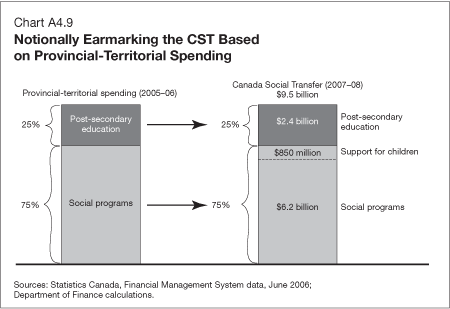
An approach similar to the one used in 2004, when the former CHST was restructured into the CST and the CHT, has been used to identify the federal earmarked contribution. Cash support for post-secondary education and social programs, including child care, is estimated based on a "spending patterns" approach that reflects provincial-territorial spending decisions (using Statistics Canada's Financial Management System).
Using this approach, approximately 25 per cent of the entire CST is earmarked as federal support for post-secondary education. The remaining portion is earmarked as federal support for other social programs. Funding already included within the social program component of the CST to support early childhood development and early learning and child care agreements will continue to be earmarked and will be extended to 2013-14.
At the same time, maintaining the block fund structure of the CST ensures provinces and territories have the flexibility to invest CST funds according to the needs and priorities of their residents.
Investing $687 million for Fair, Equal Per Capita Support
The strengthened Equalization program allows the Government to adopt equal per capita cash support for the CST and CHT in order to provide comparable treatment for all Canadians, and eliminate what the O'Brien report referred to as "back door" Equalization.
"Back door" Equalization refers to the fact that the CST and CHT take into account the fiscal capacity of provinces from the 1977 tax point transfer to determine the amount of cash a province receives. In this sense, the allocation is effectively providing a second tier of Equalization.
In 1977, the Government of Canada agreed to reduce its personal income tax rate by 13.5 percentage points and its corporate income tax rate by 1 percentage point and allowed the provinces and territories to occupy that tax room as part of federal support under Established Programs Financing for health and post-secondary education.
Provinces and territories continue to benefit from this tax transfer. The value of these tax transfers has grown from $2.7 billion in 1977 to $20.5 billion in 2006-07
The following chart shows the allocation of the CST for 2006-07. The shaded portions show the value of the tax points (after Equalization) associated with the CST. The per capita tax point values for Ontario and Alberta are worth more than those of other provinces, even after Equalization. As a result, they receive less cash per capita (the amount in white).
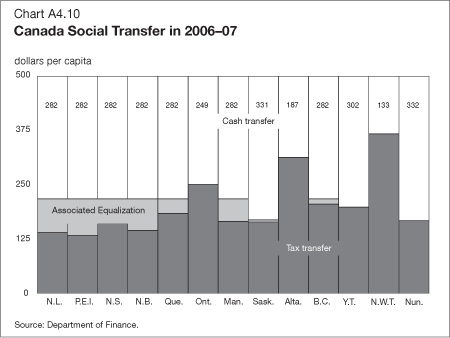
The following chart shows that for 2007-08, all provinces and territories will receive the same per capita cash support as a result of the new allocation and the increase in the total amount of CST cash. The total $289 per capita is notionally allocated for post-secondary education, support for children and social assistance and social services.
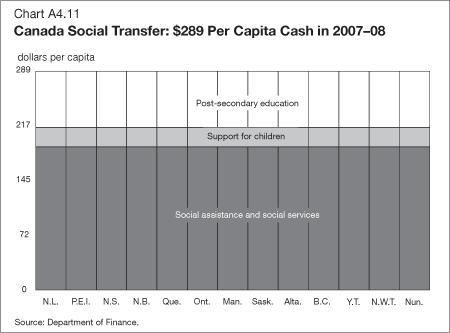
This new allocation and additional funding will also be maintained in subsequent years for the CST.
Budget 2007 proposes to increase the CST by $687 million beginning in 2007-08 to provide Ontario, Alberta and the Northwest Territories with the same per capita cash support as that of the other provinces and territories, while ensuring that no province or territory is unduly affected by this change.
To respect the agreement on the 10-Year Plan to Strengthen Health Care, which was signed by all First Ministers, the move to an equal per capita cash allocation for the CHT will be legislated to take effect in 2014-15, when the current legislation expires. As with the CST, the Government will ensure that no province or territory is unduly affected by the move to equal per capita CHT support. In the interim period, the CHT will continue to operate under the existing legislation, taking into account the value of the tax points.
A Smooth Transition to the New System
Transition provisions will ensure that no province or territory experiences declines in either its CHT or CST cash relative to what its cash transfers would have been in 2007-08 prior to the implementation of the new Equalization program and the move to equal per capita CST cash support. Declines in cash transfers could result from either the interaction between the CHT and the new Equalization program or the move to equal per capita CST cash. For example, as indicated in Chart A4.10, under the previous system Saskatchewan would have received much higher CST cash than other provinces. The new allocation will result in Saskatchewan receiving the same per capita cash as other provinces after the transition.
As a transition measure, separate payments to those provinces and territories that experience declines in either their CHT or CST cash transfers will be provided (approximately $282 million over five years, including $226 million in 2007-08).
As part of the move to make transfers more predictable and stable, discussions with provinces and territories regarding the improvements in estimation and payment cycles for the CHT and CST will be undertaken, in keeping with the changes to all of the programs.
Table A4.4Ensuring a Smooth Transition and Providing Certainty in Budget Planning: Canada Social Transfer (millions of dollars)
| N.L. | P.E.I. | N.S. | N.B. | Que. | Ont. | Man. | |
|---|---|---|---|---|---|---|---|
| 2007-08 status quo levels | 146 | 40 | 270 | 216 | 2,213 | 3,254 | 340 |
| 2007-08 new CST levels | 147 | 40 | 270 | 217 | 2,220 | 3,699 | 341 |
| Floor Payment Allocation | |||||||
| millions of dollars | |||||||
| dollars per capita | |||||||
Ensuring a Smooth Transition and Providing Certainty in Budget Planning: Canada Social Transfer (cont'd) (millions of dollars)
| Sask. | Alta. | B.C. | Y.T. | N.W.T. | Nun. | Total | |
|---|---|---|---|---|---|---|---|
| 2007-08 status quo levels | 335 | 650 | 1,311 | 10 | 6 | 10 | 8,800 |
| 2007-08 new CST levels | 284 | 983 | 1,257 | 9 | 12 | 9 | 9,487 |
| Floor Payment Allocation | |||||||
| millions of dollars | 51.3 | 54.2 | 0.6 | 1.6 | 107.6 | ||
| dollars per capita | 52.2 | 12.4 | 17.9 | 50.2 | 3.3 | ||
| Source: Department of Finance. | |||||||
Table A4.5
Ensuring a Smooth Transition and Providing Certainty in Budget Planning: Canada Health Transfer (millions of dollars)
| N.L. | P.E.I. | N.S. | N.B. | Que. | Ont. | Man. | |
|---|---|---|---|---|---|---|---|
| 2007-08 status quo levels | 347 | 95 | 639 | 512 | 5,246 | 8,034 | 807 |
| 2007-08 new CHT levels | 346 | 94 | 636 | 510 | 5,225 | 8,107 | 804 |
| Floor Payment Allocation | |||||||
| millions of dollars | 1.4 | 0.4 | 2.5 | 2.0 | 20.8 | 3.2 | |
| dollars per capita | 2.7 | 2.7 | 2.7 | 2.7 | 2.7 | 2.7 | |
Ensuring a Smooth Transition and Providing Certainty in Budget Planning: Canada Health Transfer (cont'd) (millions of dollars)
| Sask. | Alta. | B.C. | Y.T. | N.W.T. | Nun. | Total | |
|---|---|---|---|---|---|---|---|
| 2007-08 status quo levels | 756 | 1,784 | 3,065 | 22 | 18 | 24 | 21,348 |
| 2007-08 new CHT levels | 668 | 1,804 | 3,090 | 22 | 19 | 24 | 21,348 |
| Floor Payment Allocation | |||||||
| millions of dollars | 87.7 | 118.0 | |||||
| dollars per capita | 89.3 | 3.6 | |||||
| Note: Combined CST and CHT protection provides $226 million in 2007-08. Source: Department of Finance. |
|||||||
Glossary
Equalization
Equalization standard: The level of per capita fiscal capacity up to which provinces with lower per capita own-source fiscal capacity are raised by their Equalization payments.
fiscal capacity: A government's ability to raise own-source revenues. The Representative Tax System approach is used to measure tax bases in each province and territory, reflecting average taxation practices. The fiscal capacity is equal to the national average tax rate multiplied by the representative tax base.
fiscal capacity cap: A limitation on an Equalization payment that an Equalization-receiving province receives so that receiving jurisdictions do not achieve a higher total fiscal capacity, including Equalization payments, than that of jurisdictions that do not receive such payments.
fiscal disparities: The variation in the ability of different provinces to raise revenues as measured by the application of national average tax rates applied to tax bases defined in a representative way.
natural resource revenues: Royalties, licences, rents and fees derived from the development of oil and gas, minerals, forestry and water power.
net fiscal benefit: The net benefit that a province or territory receives from the development of a tax base, in particular a natural resource tax base, net of any reduction in transfers from the Government of Canada that results from any increase in provincial or territorial revenues from that tax base.
Offshore Accords: Canada-Nova Scotia Offshore Petroleum Resources Accord signed August 26, 1986; Canada-Newfoundland Atlantic Accord signed February 11, 1985; Arrangement between the Government of Canada and the Government of Nova Scotia on Offshore Revenues signed February 14, 2005; and Arrangement between the Government of Canada and the Government of Newfoundland and Labrador on Offshore Revenues signed February 14, 2005.
Representative Tax System: Simulates how much revenue a province or territory could raise if it levied the national average tax rate on each of its tax bases, measured using a representative or typical tax system.
Single-Estimate System: Annual Equalization and Territorial Formula Financing payments are calculated once per fiscal year using a three-year moving average of revenue capacity and, in the case of Territorial Formula Financing, relative population growth and changes in provincial-local government spending.
Territorial Formula Financing
eligible revenues: The measure of total territorial revenue capacity net of the 30-per-cent economic development incentive that encourages territorial governments to promote economic development and recognizes the reduced ability of territorial governments to raise revenues due to the higher cost of living in the North.
gross expenditure base: The proxy of a territorial government's expenditure requirements to provide territorial residents with a comparable level of programs and services to the rest of Canada.
PAGE: The population adjusted gross expenditure escalator applied annually to a territory's gross expenditure base to ensure that the measure of territorial expenditure requirements to provide comparable level of programs and services keeps pace with changes in relative population and changes in provincial-local government expenditures elsewhere in Canada.
resource revenue sharing: The arrangements that determine how territorial natural resource revenues received after devolution of the responsibility for the administration of onshore lands and resources offset future annual unconditional territorial grants from the Government of Canada through the Territorial Formula Financing program.
revenue block: Within the reformed Territorial Formula Financing program, the block of 11 non-resource revenues not being measured using the Representative Tax System: capital, general and miscellaneous sales, commercial and non-commercial vehicle licences, hospital and medical insurance premiums, insurance premiums, property, lottery and other games of chance revenues, miscellaneous revenues and preferred share dividends.
Canada Health Transfer/Canada Social Transfer
Associated Equalization: Equalization of the value of tax points transferred to provinces in 1977 as part of the federal government's ongoing contribution for health and post-secondary education because tax points are worth more in some provinces than others.
tax transfer: A federal tax transfer involves the federal government transferring some of its "tax room" to provincial and territorial governments. Specifically, a tax transfer occurs when, upon agreement, the federal government reduces its tax rates and provincial and territorial governments simultaneously raise their tax rates by an equivalent amount.
Table of Contents - Previous - Next -

